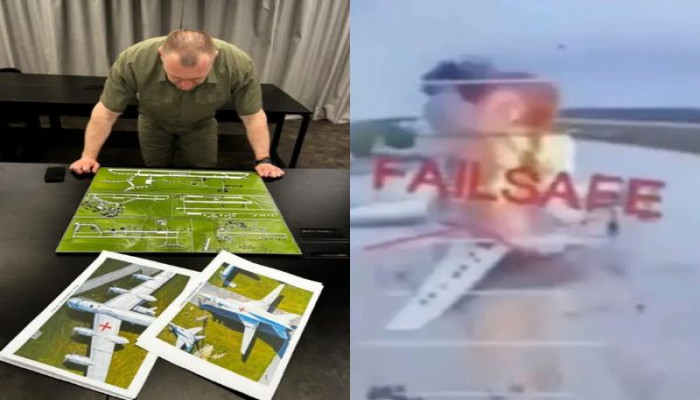Ukraine’s Operation Spider’s Web destroys over 40 Russian warplanes in deep strike drone attack
- In Reports
- 06:27 PM, Jun 02, 2025
- Myind Staff
Ukraine initiated Operation Spider’s Web on June 1, 2025. It planned the drone strike and targeted four Russian airbases: Olenya, Belaya, Ivanovo, and Dyagilevo.
President Volodymyr Zelensky personally oversaw the operation. Ukraine deployed 117 drones during the attack. The drones destroyed over 40 Russian military aircraft, including Tu-22M3 and Tu-95 strategic bombers, as well as an A-50 airborne early warning aircraft.
Zelensky praised the Security Service of Ukraine (SBU), its chief General Vasyl Maliuk, and all involved operatives. He confirmed that the operation took more than a year and a half to prepare.
He said, “Planning, organisation, every detail was perfectly executed. I can say with certainty that this is an absolutely unique operation.”
Zelensky disclosed that the operational hub was located inside Russia. He revealed that Ukraine had positioned it next to an FSB headquarters in one of the regions. He stated that this detail had now become public.
He elaborated further on the operation’s scale. “In total, 117 drones were used in the operation, with a corresponding number of drone operators involved. 34% of the strategic cruise missile carriers stationed at air bases were hit.”
He added that Ukrainian personnel operated across several Russian regions and worked across three different time zones.
He confirmed that Ukraine had evacuated the individuals who assisted with the operation from Russian territory before it began. He assured that they were safe. He concluded, “Glory to Ukraine!”
Ukraine concealed the drones inside specially modified trucks. It hid the launch systems under remote-controlled roofs.
The trucks were parked near the targeted airbases. This allowed a surprise attack deep inside Russian territory. Some of the airbases were more than 4,300 kilometres from the Ukrainian border.
Tactical execution and technological innovation
Ukraine demonstrated major advances in drone warfare and strategy during Operation Spider’s Web.
The drones used artificial intelligence-based targeting systems. These systems identified and struck critical parts of the aircraft, such as fuel tanks, to cause maximum damage.
Ukraine credited the success to more than 18 months of covert planning. This included smuggling drones across borders and setting up operational bases inside Russia.
Ukraine built these bases near Russian intelligence facilities. This made it possible to launch drones from behind enemy lines.
Strategic impact on Russian military capabilities
The drones destroyed more than one-third of Russia’s strategic bomber fleet. This dealt a serious blow to Russia’s long-range aerial capabilities.
The estimated financial loss from the damage stood at around $7 billion.
By destroying Tu-95 and Tu-22M3 bombers, Ukraine weakened Russia’s ability to carry out missile strikes from the air. This also reduced Russia’s strategic flexibility.
Ukraine also targeted and destroyed A-50 airborne radar systems. These systems were crucial for battlefield surveillance. Their loss marked another major setback.
The strike degraded Russia’s long-range strike capacity. It also revealed major vulnerabilities in its air defence network.
In response to the operation’s effectiveness, Russia began reviewing its security protocols for critical military infrastructure.
Implications for future military operations
Operation Spider’s Web marked a key turning point in the use of unmanned systems in modern warfare.
Ukraine showed that it could carry out coordinated attacks in multiple regions. It struck high-value targets while keeping its personnel out of harm’s way.
Ukraine used AI-enabled drones, placed launch platforms near FSB sites, and coordinated its mission across different time zones.
This proved Ukraine’s growing capacity to conduct highly efficient asymmetric operations.
Military experts believe this success will shape the strategic use of drones by both allied and opposing forces.
As the conflict continues, Ukraine’s use of advanced technology on the battlefield may transform how modern wars are fought. It could also influence global defence and intelligence planning in the months ahead.







Comments